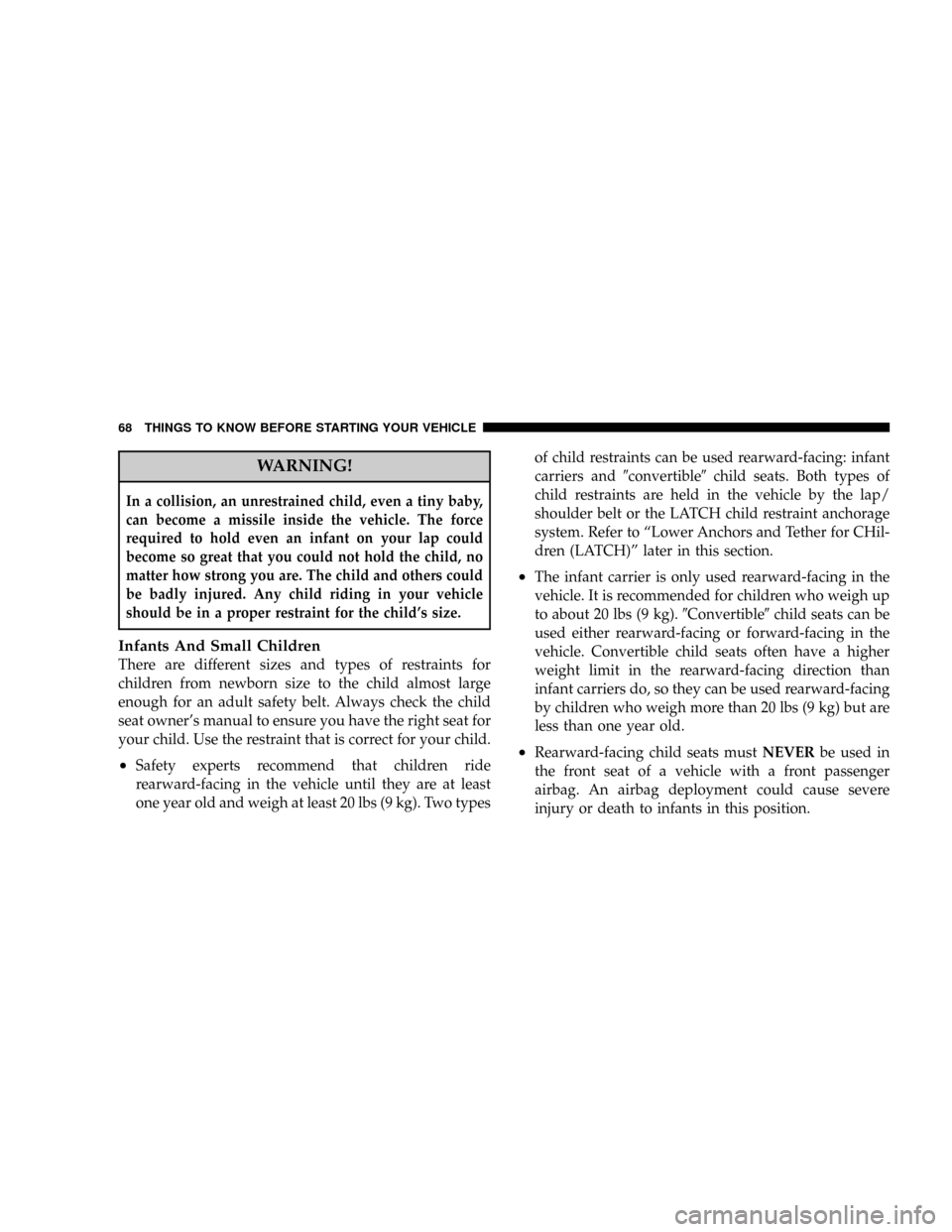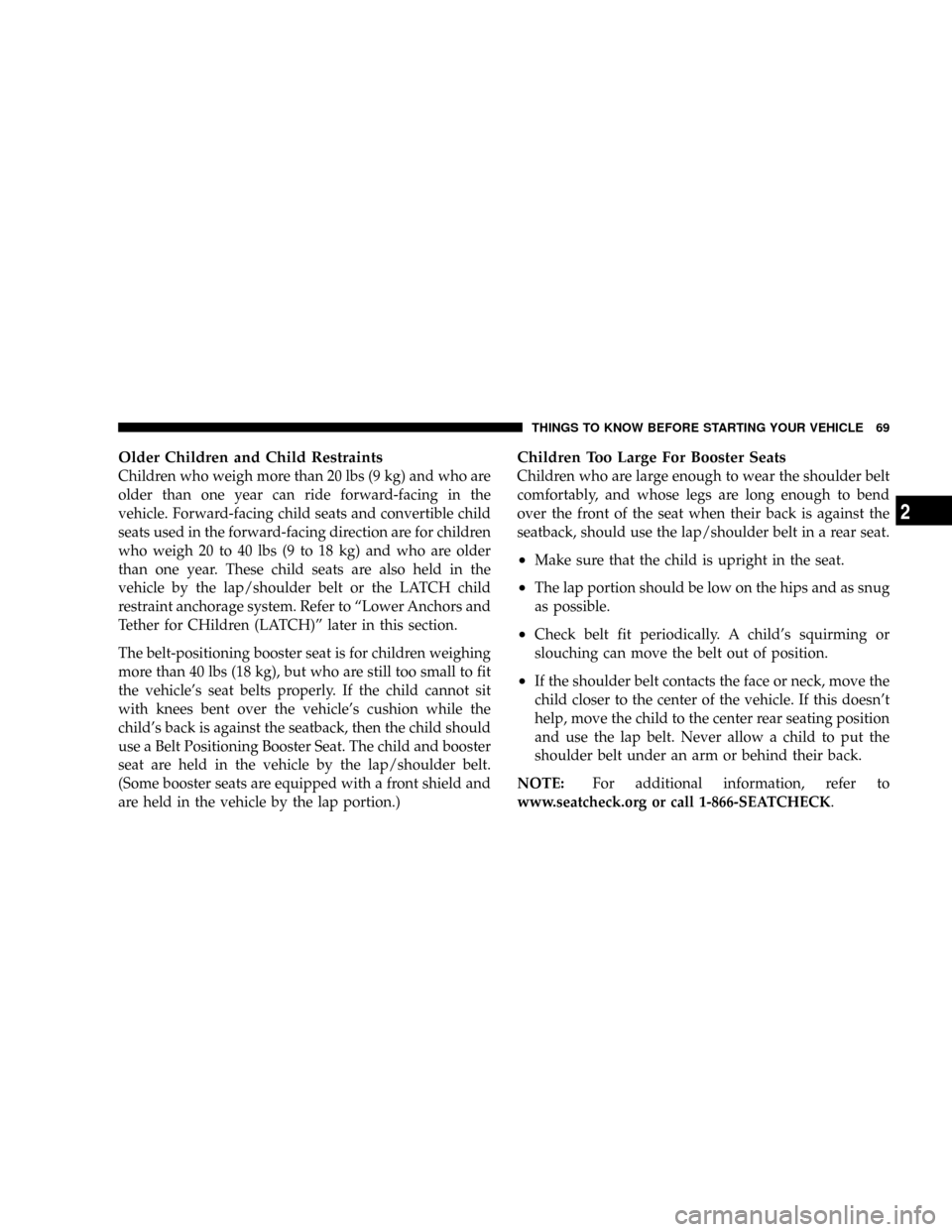2008 CHRYSLER PACIFICA LATCH
[x] Cancel search: LATCHPage 46 of 457

2. At about 6 to 12 inches (15 to 30 cm) above the latch
plate, grasp and twist the belt webbing 180É to create a
fold that begins immediately above the latch plate.3. Slide the latch plate upward over the folded webbing.
The folded webbing must enter the slot at the top of the
latch plate.
4. Continue to slide the latch plate up until it clears the
folded webbing.
Grasp and TwistSlide the latch plate upward over the folded webbing
46 THINGS TO KNOW BEFORE STARTING YOUR VEHICLE
Page 49 of 457

Automatic-Locking Retractor (ALR)
The center seating position on vehicles equipped with a
second row bench seat is equipped with an Automatic-
Locking Retractor (ALR). Pull the belt from the retractor
until there is enough to allow you to pass through the
child restraint and slide the latch plate into the buckle.
Then pull on the belt until it is all removed from the
retractor. Allow the belt to return into the retractor,
pulling on the excess webbing to tighten the lap portion
about the child restraint. Follow the instructions of the
child restraint manufacturer.
NOTE:To reset this feature you must let all of the belt
webbing return into the retractor. You will not be able to
pull out more webbing until all of the webbing has been
returned back into the retractor.
Seat Belts and Pregnant Women
We recommend that pregnant women use the seat belts
throughout their pregnancy. Keeping the mother safe is
the best way to keep the baby safe.
Pregnant women should wear the lap part of the belt
across the thighs and as snug across the hips as possible.
Keep the belt low so that it does not come across the
abdomen. That way the strong bones of the hips will take
the force if there is a collision.
Seat Belt Extender
If a seat belt is too short, even when fully extended and
when the adjustable upper shoulder belt anchorage (if
equipped) is in its lowest position, your dealer can
provide you with a seat belt extender. This extender
should be used only if the existing belt is not long
enough. When it is not required, remove the extender
and stow it.
THINGS TO KNOW BEFORE STARTING YOUR VEHICLE 49
2
Page 68 of 457

WARNING!
In a collision, an unrestrained child, even a tiny baby,
can become a missile inside the vehicle. The force
required to hold even an infant on your lap could
become so great that you could not hold the child, no
matter how strong you are. The child and others could
be badly injured. Any child riding in your vehicle
should be in a proper restraint for the child's size.
Infants And Small Children
There are different sizes and types of restraints for
children from newborn size to the child almost large
enough for an adult safety belt. Always check the child
seat owner's manual to ensure you have the right seat for
your child. Use the restraint that is correct for your child.
²Safety experts recommend that children ride
rearward-facing in the vehicle until they are at least
one year old and weigh at least 20 lbs (9 kg). Two typesof child restraints can be used rearward-facing: infant
carriers and9convertible9child seats. Both types of
child restraints are held in the vehicle by the lap/
shoulder belt or the LATCH child restraint anchorage
system. Refer to ªLower Anchors and Tether for CHil-
dren (LATCH)º later in this section.
²The infant carrier is only used rearward-facing in the
vehicle. It is recommended for children who weigh up
to about 20 lbs (9 kg).9Convertible9child seats can be
used either rearward-facing or forward-facing in the
vehicle. Convertible child seats often have a higher
weight limit in the rearward-facing direction than
infant carriers do, so they can be used rearward-facing
by children who weigh more than 20 lbs (9 kg) but are
less than one year old.
²Rearward-facing child seats mustNEVERbe used in
the front seat of a vehicle with a front passenger
airbag. An airbag deployment could cause severe
injury or death to infants in this position.
68 THINGS TO KNOW BEFORE STARTING YOUR VEHICLE
Page 69 of 457

Older Children and Child Restraints
Children who weigh more than 20 lbs (9 kg) and who are
older than one year can ride forward-facing in the
vehicle. Forward-facing child seats and convertible child
seats used in the forward-facing direction are for children
who weigh 20 to 40 lbs (9 to 18 kg) and who are older
than one year. These child seats are also held in the
vehicle by the lap/shoulder belt or the LATCH child
restraint anchorage system. Refer to ªLower Anchors and
Tether for CHildren (LATCH)º later in this section.
The belt-positioning booster seat is for children weighing
more than 40 lbs (18 kg), but who are still too small to fit
the vehicle's seat belts properly. If the child cannot sit
with knees bent over the vehicle's cushion while the
child's back is against the seatback, then the child should
use a Belt Positioning Booster Seat. The child and booster
seat are held in the vehicle by the lap/shoulder belt.
(Some booster seats are equipped with a front shield and
are held in the vehicle by the lap portion.)
Children Too Large For Booster Seats
Children who are large enough to wear the shoulder belt
comfortably, and whose legs are long enough to bend
over the front of the seat when their back is against the
seatback, should use the lap/shoulder belt in a rear seat.
²Make sure that the child is upright in the seat.
²The lap portion should be low on the hips and as snug
as possible.
²Check belt fit periodically. A child's squirming or
slouching can move the belt out of position.
²If the shoulder belt contacts the face or neck, move the
child closer to the center of the vehicle. If this doesn't
help, move the child to the center rear seating position
and use the lap belt. Never allow a child to put the
shoulder belt under an arm or behind their back.
NOTE:For additional information, refer to
www.seatcheck.org or call 1-866-SEATCHECK.
THINGS TO KNOW BEFORE STARTING YOUR VEHICLE 69
2
Page 70 of 457

WARNING!
²Improper installation can lead to failure of an
infant or child restraint. It could come loose in a
collision. The child could be badly injured or
killed. Follow the manufacturer's directions ex-
actly when installing an infant or child restraint.
²A rearward facing child restraint should only be
used in a rear seat. A rearward facing child re-
straint in the front seat may be struck by a deploy-
ing passenger airbag which may cause severe or
fatal injury to the infant.
Here are some tips on getting the most out of your child
restraint:
²Before buying any restraint system, make sure that it
has a label certifying that it meets all applicable Safety
Standards. We also recommend that you make surethat you can install the child restraint in the vehicle
where you will use it, before you buy it.
²The restraint must be appropriate for your child's
weight and height. Check the label on the restraint for
weight and height limits.
²Carefully follow the instructions that come with the
restraint. If you install the restraint improperly, it may
not work when you need it.
The passenger seat belts are equipped with cinching
latch plates, which are designed to keep the lap
portion tight around the child restraint so that it is not
necessary to use a locking clip. Pulling up on the
shoulder portion of the lap/shoulder belt will tighten
the belt. The cinching latch plate will keep the belt
tight, however, any seat belt system will loosen with
time, so check the belt occasionally and pull it tight if
necessary.
70 THINGS TO KNOW BEFORE STARTING YOUR VEHICLE
Page 71 of 457

²In the rear seat, you may have trouble tightening the
lap/shoulder belt on the child restraint because the
buckle or latch plate is too close to the belt path
opening on the restraint. Disconnect the latch plate
from the buckle and twist the short buckle end of the
belt several times to shorten it. Insert the latch plate
into the buckle with the release button facing out.
²If the belt still can't be tightened, or if pulling and
pushing on the restraint loosens the belt, disconnect
the latch plate from the buckle, turn the buckle
around, and insert the latch plate into the buckle
again. If you still can't make the child restraint secure,
try a different seating position.
²Buckle the child into the seat according to the child
restraint manufacturer's directions.
²When your child restraint is not in use, secure it in the
vehicle with the seat belt or remove it from the vehicle.
Don't leave it loose in the vehicle. In a sudden stop or
collision, it could strike the occupants or seatbacks and
cause serious personal injury.
Lower Anchors and Tether for CHildren (LATCH)
Each vehicle is equipped with two child restraint anchor-
age systems called LATCH, which stands for Lower
Anchors and Tether for CHildren. The LATCH child
restraint anchorage systems are installed on second-row
seats only. LATCH child restraint anchorage systems are
not provided on the six passenger third row seats.
THINGS TO KNOW BEFORE STARTING YOUR VEHICLE 71
2
Page 72 of 457

Six passenger vehicles are equipped with second row
fold & tumble seats with lower anchorages that can
accommodate rigid mount or flexible webbing-mounted
LATCH-compatible child seats. The third row seating
positions are not equipped with lower anchorages. How-
ever, the third row driver side seating position is
equipped with a tether anchor. If you are installing
LATCH-compatible child restraints in any third row
seating position, you must use the vehicle's seat belt.
Five passenger vehicles are equipped with a second row
bench seat only. The two outboard seating positions have
lower anchorages that can accommodate rigid mount or
flexible webbing-mounted LATCH-compatible child
seats. The center seating position of the bench seat can
LATCH ANCHORS
72 THINGS TO KNOW BEFORE STARTING YOUR VEHICLE
Page 73 of 457

also accommodate a flexible webbing-mounted LATCH-
compatible child seat by using the inboard lower anchors
of the two outboard seating positions. A rigid mount seat
can only be installed at this seating location by using the
vehicle's seat belt. Regardless of the specific type of lower
attachment, NEVER install LATCH-compatible child
seats such that two child seats share a common lower
anchorage. If you are installing LATCH-compatible child
restraints in adjacent rear seating positions, you can use
the LATCH anchors or the vehicle's seat belt for the
outboard position, but you must use the vehicle's seat
belt at the center position.
The lower anchor bars of the LATCH System are located
where the seat back meets the seat cushion. The tether
anchors are located on the rear surface of the seat. Child
restraint systems designed to be compatible with the
vehicles LATCH System are now available. LATCH child
restraints make installation into the vehicle simple and
Bench Seat LATCH Anchors
THINGS TO KNOW BEFORE STARTING YOUR VEHICLE 73
2